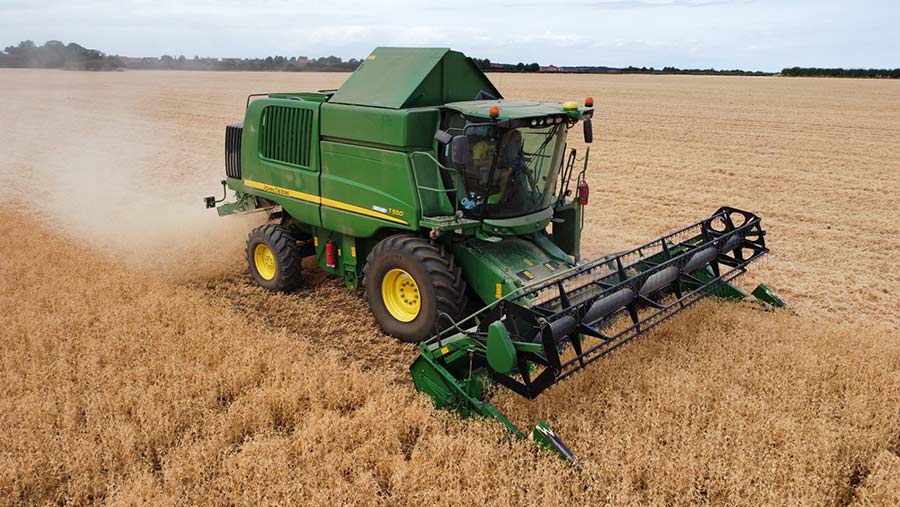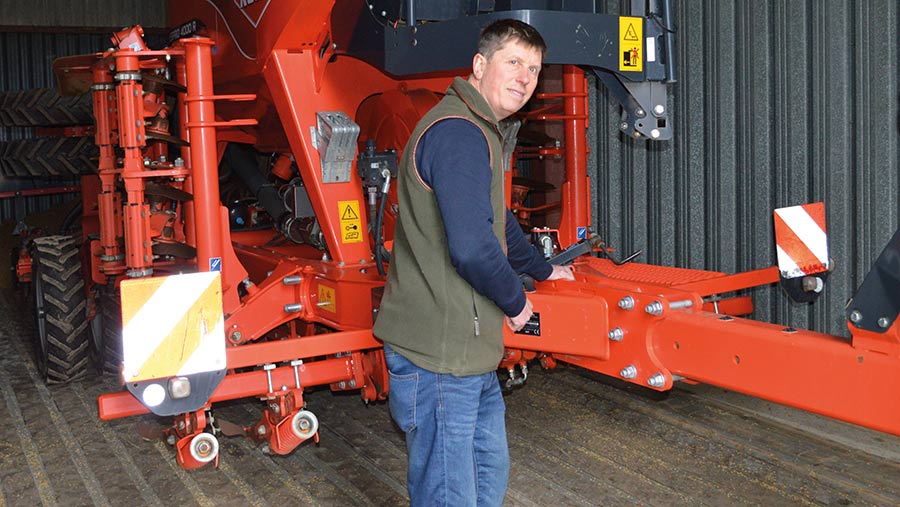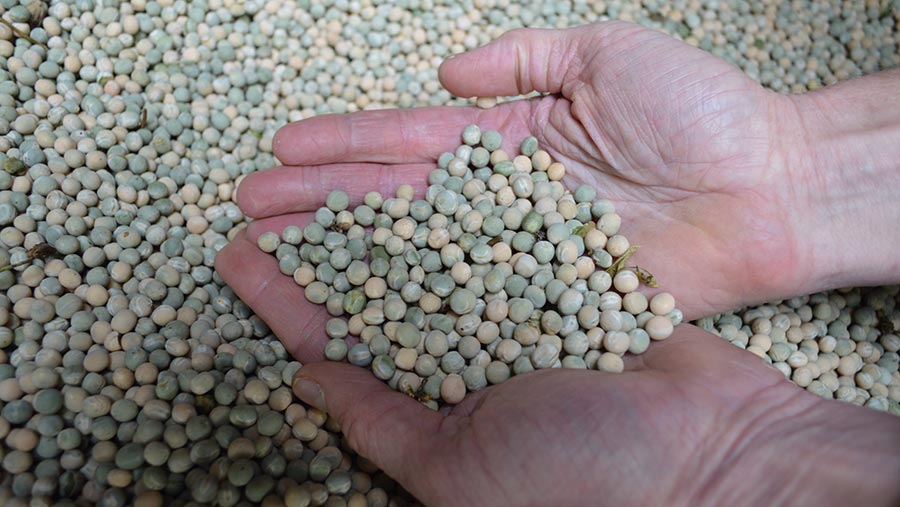Peas widen rotation and lower input costs for Norfolk grower
 © David Wroth
© David Wroth David Wroth is incorporating combinable peas into his extended six-year crop rotation after two successful seasons.
He sees them as the best combinable crop to cope with the now-commonplace dry springs on his north Norfolk light land farm.
His pea yields are rising while input costs are half those of spring barley, and the residual nitrogen left by the pulse crop sees his following winter cereal crop get off to a very good start.
This means he can look to cut back on nitrogen fertiliser the following spring.
See also: Farmers join forces to grow high-yield low-cost spring beans
“Peas seem to be able to cope with the dry summers better than other combinable crops. What they don’t like is wet-dry conditions which can cause peas to split and damage quality and colour,” he tells Farmers Weekly.
Farm facts
- Bell Farm, Docking, Norfolk
- Farm manager – David Wroth
- 265ha of light sandy loams growing winter barley, oilseed rape, winter wheat, sugar beet, spring barley and combine peas
- 65 Red Poll cattle
Second successful year
We first visited him in early 2022 after his initial success with his first pea crop in 2021, and now in only his second year of growing peas in 2022, Mr Wroth has harvested a crop of the green pea variety Aviator.
The variety yielded 4.2t/ha across 38ha, persuading him to make peas part of his regular crop rotation.
He has extended his five-year rotation of winter wheat/oilseed rape/winter wheat/sugar beet/spring barley to six years by adding combinable peas after spring barley on the 265ha of light sandy loam soils he manages.
Mr Wroth was attracted to the pea crop by its low inputs, with no nitrogen fertiliser needed for this pulse crop which can fix its own nitrogen from the atmosphere.
An extra spring crop helps him widen his rotation, seasonal workload is better spread, and the crop suits his light land.
“The peas seem to like the dry conditions, what they don’t like is being soaked with rain and then standing with wet feet in humid and damp conditions,” he adds.

David Wroth © MAG/David Jones
Commercial crops
Although his pea crop is grown for seed, a commercial crop of the variety Aviator could fetch up to nearly £400/t for good human consumption samples to be used in canning, soups and mushy peas.
The variety could even make £310-£320/t for lower quality animal feed.
With no fertiliser needed and spraying costs for the pea crop of just £130/ha, this is about half the spray and fertiliser costs for growing malting spring barley on the farm.
Tom Barker, cereals and pulse product manager for Aviator plant breeder Limagrain, says the variety shows a unique architecture.
Most of the pods are near the top of the plant, which keeps these valuable elements away from the ground and makes for generally easy harvesting with the combine.
Mr Wroth first looked at combinable peas in 2021 to replace some of his area of sugar beet, which was then producing poor financial returns and was damaging his soils with late lifting.
The 16ha of a seed crop of Aviator he drilled that year yielded 3.5t/ha in his first attempt with peas, but he then followed it with 4.2t/ha over 38ha in 2022.
Although the sugar beet price for the 2023 crop has risen 48% to £40/t, so making the beet crop more financially viable, Mr Wroth says that peas are firmly part of his rotation.
The crop is well suited to his light land and doesn’t cause heavy damage to his soils.

© MAG/David Jones
Growing regime
His 2022 pea crop was grown after winter wheat with the wheat straw chopped and left over winter.
Then in the spring, the land was sprayed off with glyphosate, cultivated and drilled on 24 March, and then immediately rolled.
The biostimulant seed dressing Exseed was used to get the peas off to a good start.
The rolling was the only major difference from 2021, as although the crop was drilled in near-perfect conditions there was little rain in the forecast and conserving moisture was key.
This proved to be a good move as there was no rain from drilling until the end of April, as the spring and summer drought set in.
The major problem with growing peas in the spring comes from pigeons, which can hit the crop badly just after emergence and again at flowering time.
A combination of gas guns, flag deterrents and circling Red Kites in the area managed to keep the pigeon damage under control.
Insecticide sprays were used to keep pea moth at bay and a strobilurin fungicide was applied to control downy mildew throughout the growing season, with manganese added as a micronutrient.
Standing well at harvest
Each plant appeared to hold up those surrounding it and so very little lodging was seen and, although lifters were used on the John Deere T550 combine, the crop stood very well.
Another key advantage of pea crops is the valuable residual nitrogen they leave in the ground for the next crop, and in Mr Wroth’s crop rotation the next crop is winter barley.
“Winter barley grown after peas is up and away quickly, and has yielded more than when the winter barley is grown as a second cereal,” he says.
He grows two winter malting barley varieties – Vessel and Flagon. The former is grown for seed so grain nitrogen content is not critical, while he looks for a low nitrogen malting sample from the Flagon.
After the benefits of residual nitrogen from the beans, he will look to reduce nitrogen fertiliser in the spring by about 10-15kg/ha on both varieties.
The pea area for 2023 will come down to about 20ha due to the rotation reasons, but Mr Wroth sees peas in the future accounting for a steady 30-40ha of his arable rotation.
Pea crop at Bell Farm |
| Variety Green pea variety Aviator, grown for seed |
| Previous crop Winter wheat |
| Preparation – Cultivated with tine-disc-packer Cousins Patriot on March 22 after being sprayed off with glyphosate |
| Drilling Sown with Kuhn Espro 4m disc drill on 24 March at 90 seeds/sq m at 50mm depth and rolled |
| Seed treatment Exseed biostimulant |
| Pre-emergence herbicide Nirvana (imazamox + pendimethalin) and Mohawk (clomazone) |
| Insecticide + micronutrients Stealth (pyrethroid lambda-cyhalothrin) plus manganese on April 19 |
| Fungicide + insecticide Vertaza (azoxystrobin) plus Stealth and pirimicarb on 8 June |
| Insecticide Hallmark (pyrethroid) on 25 June |
| Harvested 27 July. |

